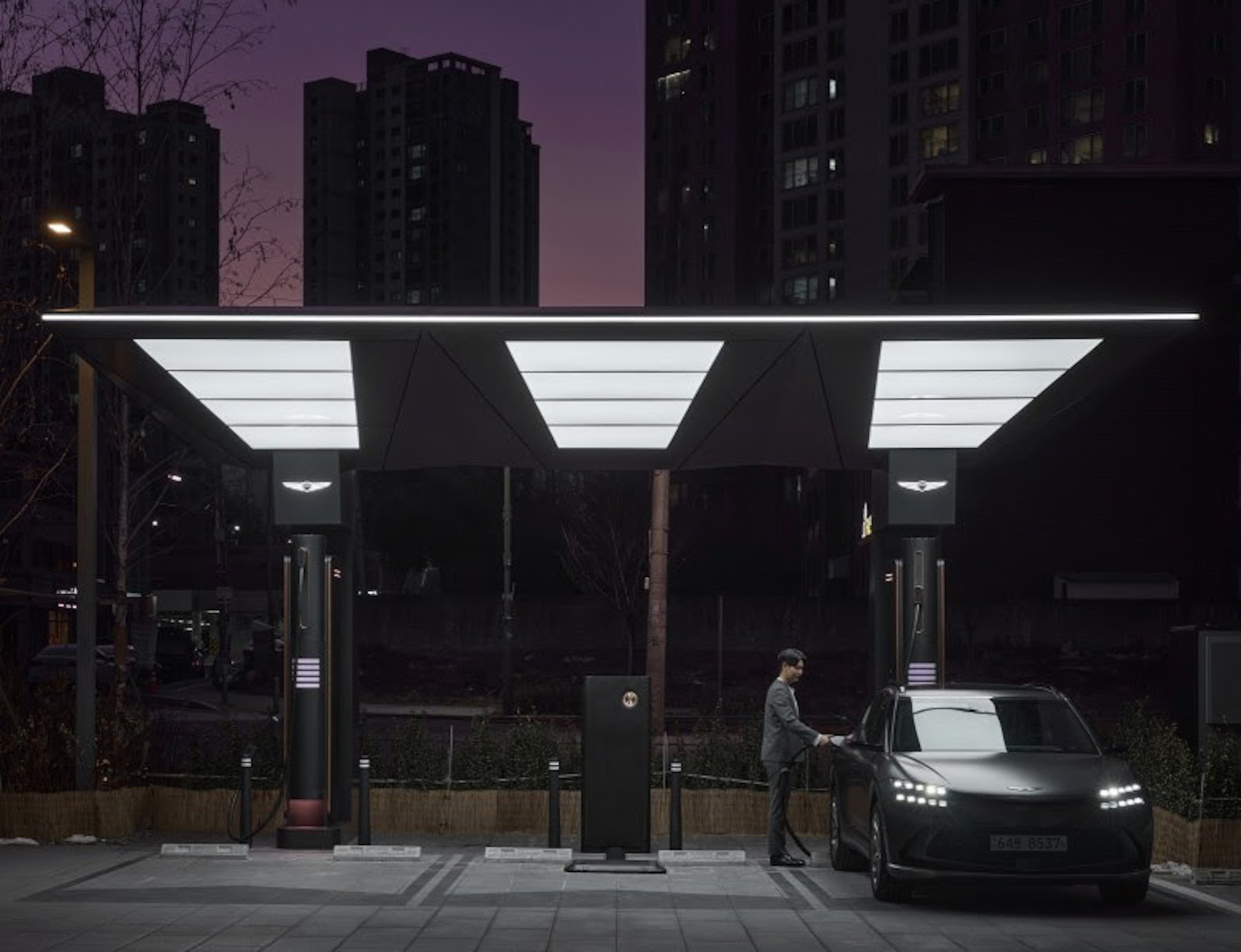With stations completed this month throughout South Korea’s most populated province, Gyeonggi-do, LA-based design and architecture firm Morphosis has partnered with automotive luxury brand Genesis to bring their signature brand and styling, attention-to-detail, and seamless customer experience to the design of Electric Vehicle Charging (EVC) Stations. The first phase of domestic deployment includes five sites throughout South Korea’s most populated metropolitan zones: Seoul and Gyeonggi-do, including stations in Genesis’ flagship showrooms, Suji and Gangnam, as well as other locations in Seoul and Goyang. The canopies are designed to be modularized and replicated in future expansions within Korea and beyond.
“From design concept to the smallest crafted detail, the defining design identity of the Genesis brand are materialized in the charging stations: the wing emblem, the two lines and the Athletic Elegance,” says Morphosis Design Partner Ung-Joo Scott Lee. “As leaders in both design and mobility, we are inspired to imagine new ways of thinking about the infrastructure needed for charging electric vehicles while providing Genesis new opportunities to connect and support its customers as we enter into the era of full vehicular electrification.”
Strategically Designed EVC Stations
The exterior EVC Stations are designed to serve as protective canopies made of aluminum panels on a steel superstructure. The winged form of the canopy is instantly recognizable within the urban environment, with a lightness and elegance that evokes the distinctive Genesis wing emblem and Genesis’ core design identity of “Athletic Elegance.”
The razor-thin canopy edge integrates a continuous LED light feature identifying the charging stations, with future capability of changing colors to indicate the electric vehicle charging level. The stations encompass a range of indoor and outdoor adaptations to respond to different climates and site conditions.
To address the unique existing conditions at each interior location, the design introduces a set of recognizable surfaces and forms identifying the EVC locations. The exterior canopies are designed in three different forms to accommodate different site parameters and requirements. “Double” and “triple” canopies accommodate additional chargers, allowing multiple vehicles to be charged at once. The new EVC stations are compatible with Genesis’ electric vehicles and the ultra-fast chargers can fully charge these vehicles in as little as 20 minutes.
Related Stories
Transportation & Parking Facilities | Aug 23, 2023
California parking garage features wind-activated moving mural
A massive, colorful, moving mural creatively conceals a newly opened parking garage for a global technology company in Mountain View, Calif.
Digital Twin | Jul 31, 2023
Creating the foundation for a Digital Twin
Aligning the BIM model with the owner’s asset management system is the crucial first step in creating a Digital Twin. By following these guidelines, organizations can harness the power of Digital Twins to optimize facility management, maintenance planning, and decision-making throughout the building’s lifecycle.
Designers | Jul 25, 2023
The latest 'five in focus' healthcare interior design trends
HMC Architects’ Five in Focus blog series explores the latest trends, ideas, and innovations shaping the future of healthcare design.
Digital Twin | Jul 17, 2023
Unlocking the power of digital twins: Maximizing success with OKRs
To effectively capitalize on digital twin technology, owners can align their efforts using objectives and key results (OKRs).
Standards | Jun 26, 2023
New Wi-Fi standard boosts indoor navigation, tracking accuracy in buildings
The recently released Wi-Fi standard, IEEE 802.11az enables more refined and accurate indoor location capabilities. As technology manufacturers incorporate the new standard in various devices, it will enable buildings, including malls, arenas, and stadiums, to provide new wayfinding and tracking features.
Virtual Reality | Jun 16, 2023
Can a VR-enabled AEC Firm transform building projects?
With the aid of virtual reality and 3D visualization technologies, designers, consultants, and their clients can envision a place as though the project were in a later stage.
AEC Innovators | Jun 15, 2023
Rogers-O'Brien Construction pilots wearables to reduce heat-related injuries on jobsites
Rogers-O'Brien Construction (RO) has launched a pilot program utilizing SafeGuard, a safety-as-a-service platform for real-time health and safety risk assessment. Non-invasive wearables connected to SafeGuard continuously monitor personnel to prevent heat exhaustion on jobsites, reducing the risk of related injuries. RO is the first general contractor to pilot this program.
Contractors | May 26, 2023
Enhanced use of data is crucial for improving construction job site safety
Executives with major construction companies say new digital tools are allowing them to use data more effectively to reduce serious safety incidents and improve job site safety.
AEC Tech Innovation | May 12, 2023
Meet Diverge, Hensel Phelps' new ConTech investment company
Thai Nguyen, Director of Innovation with Hensel Phelps, discusses the construction giant's new startup investment platform, Diverge.
AEC Tech | May 9, 2023
4 insights on building product manufacturers getting ‘smart’
Overall, half of building product manufacturers plan to invest in one or more areas of technology in the next three years.

















